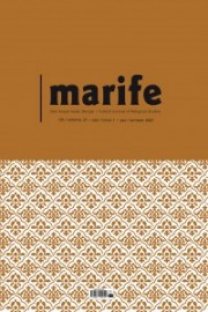Birleştirilmiş Hadis Metinleri Üzerine Bir Deneme: Borçlunun Cenaze Namazı ile İlgili Rivâyet
Hadis ve sünnetin, rivâyet sırasında, birtakım râvî tasarruflarına maruz kaldığı bilinmektedir. Hadis kitaplarında zaman zaman rastlanan ve birleştirilmiş/birleşik olarak nitelenebilen bazı hadis metinleri ise bu tasarrufların bir şeklini oluşturmaktadır. Birleşik hadisler, Hz. Peygamber’in değişik zamanlarda gerçekleşmiş bazı fiillerinin aynı anda gerçekleşmiş gibi veya biri diğerinden bağımsız hadislerinin bir araya getirilerek, tek hadis gibi sunulması ile oluşmuştur. Dolayısıyla o, telfîku’l-hadis gibi geçmişte ve metin inşası gibi günümüzde uygulanan ve aynı hadisin diğer rivâyetlerini esas alan birleştirme şekillerinden farklıdır. Bu çalışmada, Hz. Peygamber’in birleştirilerek rivâyet edilmiş fiilleri, borçlu üç kişinin cenaze namazı konusundaki tutumunun anlatıldığı örnek bir rivâyet ile ele alınmaktadır. Bu örnekte üç farklı olay sanki art arda ve aynı gün içinde gerçekleşmiş gibi anlatılmıştır. Ancak elde edilen bulgulardan hareketle bu üç cenaze namazının farklı zamanlarda kılındığı ve rivâyetin birleştirilmiş olduğu sonucuna ulaşmak mümkündür
A Study on The Combined Texts of Hadiths: a Narration About the Funeral Prayer for the Debtors
A Study on The Combined Texts of Hadiths: a Narration About the Funeral Prayer for the Debtors It is wellknowen that narrators of hadith had some influences on the texts of hadisths and sunnah at the time of narration. Some texts of hadith, stuated in the books of hadith and abled to be found acceptable as united narrations, constitute a type of these influences. The combined texts of hadiths was formed with insunuating the Holy Prophet’s practices appeared at the different times as if they were appeared at the same time and his some different and independent hadiths as if they were only one hadith. So that the combined texts of hadiths seem to be different from the type of combining the texts like talfik al- hadith, the ancient practice, and textual construction, the new practice, which focus to the different versions of a hadith. In this article, the Holy Prophet’s combined practices are studied with a characteristic narration in which the Prophet’s way of behaving to the three debtors was narrated. In this narration, three different practice were telled as if they were continuously appeared at the same time. However, its possible to say that these three prayers on three debtors were separately performed and unitedly narrated
